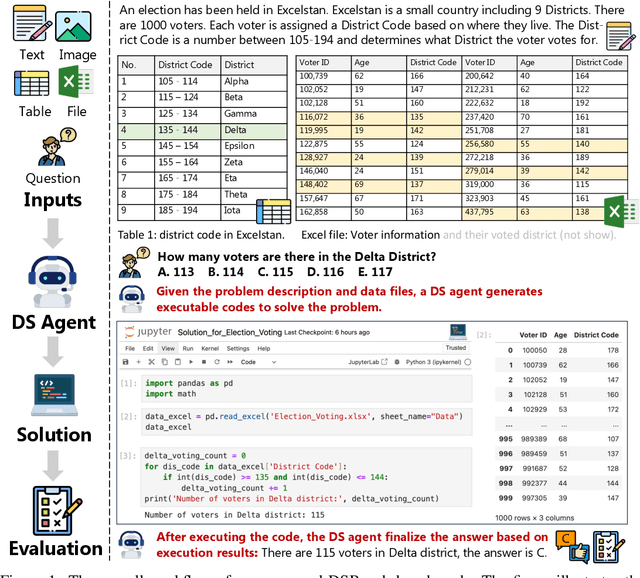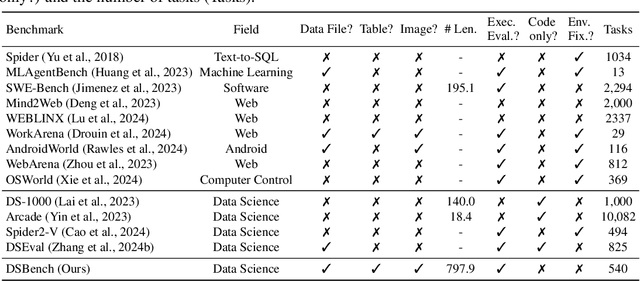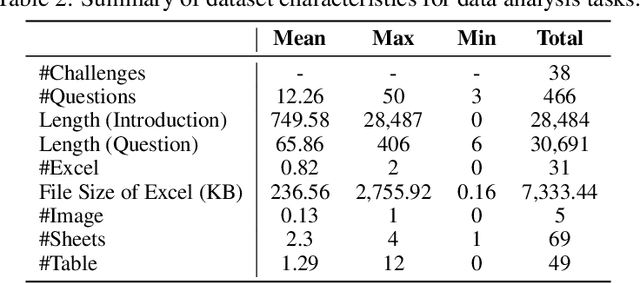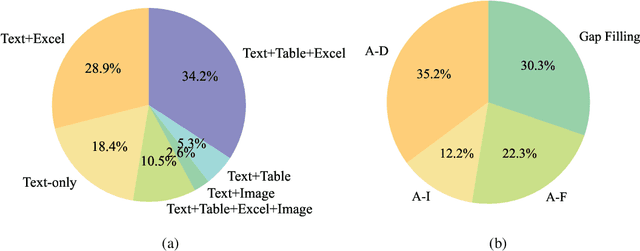Wenlin Yao
Towards Trustworthy GUI Agents: A Survey
Mar 30, 2025Abstract:GUI agents, powered by large foundation models, can interact with digital interfaces, enabling various applications in web automation, mobile navigation, and software testing. However, their increasing autonomy has raised critical concerns about their security, privacy, and safety. This survey examines the trustworthiness of GUI agents in five critical dimensions: security vulnerabilities, reliability in dynamic environments, transparency and explainability, ethical considerations, and evaluation methodologies. We also identify major challenges such as vulnerability to adversarial attacks, cascading failure modes in sequential decision-making, and a lack of realistic evaluation benchmarks. These issues not only hinder real-world deployment but also call for comprehensive mitigation strategies beyond task success. As GUI agents become more widespread, establishing robust safety standards and responsible development practices is essential. This survey provides a foundation for advancing trustworthy GUI agents through systematic understanding and future research.
Interpreting and Steering LLMs with Mutual Information-based Explanations on Sparse Autoencoders
Feb 21, 2025Abstract:Large language models (LLMs) excel at handling human queries, but they can occasionally generate flawed or unexpected responses. Understanding their internal states is crucial for understanding their successes, diagnosing their failures, and refining their capabilities. Although sparse autoencoders (SAEs) have shown promise for interpreting LLM internal representations, limited research has explored how to better explain SAE features, i.e., understanding the semantic meaning of features learned by SAE. Our theoretical analysis reveals that existing explanation methods suffer from the frequency bias issue, where they emphasize linguistic patterns over semantic concepts, while the latter is more critical to steer LLM behaviors. To address this, we propose using a fixed vocabulary set for feature interpretations and designing a mutual information-based objective, aiming to better capture the semantic meaning behind these features. We further propose two runtime steering strategies that adjust the learned feature activations based on their corresponding explanations. Empirical results show that, compared to baselines, our method provides more discourse-level explanations and effectively steers LLM behaviors to defend against jailbreak attacks. These findings highlight the value of explanations for steering LLM behaviors in downstream applications. We will release our code and data once accepted.
OpenWebVoyager: Building Multimodal Web Agents via Iterative Real-World Exploration, Feedback and Optimization
Oct 25, 2024



Abstract:The rapid development of large language and multimodal models has sparked significant interest in using proprietary models, such as GPT-4o, to develop autonomous agents capable of handling real-world scenarios like web navigation. Although recent open-source efforts have tried to equip agents with the ability to explore environments and continuously improve over time, they are building text-only agents in synthetic environments where the reward signals are clearly defined. Such agents struggle to generalize to realistic settings that require multimodal perception abilities and lack ground-truth signals. In this paper, we introduce an open-source framework designed to facilitate the development of multimodal web agent that can autonomously conduct real-world exploration and improve itself. We first train the base model with imitation learning to gain the basic abilities. We then let the agent explore the open web and collect feedback on its trajectories. After that, it further improves its policy by learning from well-performing trajectories judged by another general-purpose model. This exploration-feedback-optimization cycle can continue for several iterations. Experimental results show that our web agent successfully improves itself after each iteration, demonstrating strong performance across multiple test sets.
SePPO: Semi-Policy Preference Optimization for Diffusion Alignment
Oct 07, 2024



Abstract:Reinforcement learning from human feedback (RLHF) methods are emerging as a way to fine-tune diffusion models (DMs) for visual generation. However, commonly used on-policy strategies are limited by the generalization capability of the reward model, while off-policy approaches require large amounts of difficult-to-obtain paired human-annotated data, particularly in visual generation tasks. To address the limitations of both on- and off-policy RLHF, we propose a preference optimization method that aligns DMs with preferences without relying on reward models or paired human-annotated data. Specifically, we introduce a Semi-Policy Preference Optimization (SePPO) method. SePPO leverages previous checkpoints as reference models while using them to generate on-policy reference samples, which replace "losing images" in preference pairs. This approach allows us to optimize using only off-policy "winning images." Furthermore, we design a strategy for reference model selection that expands the exploration in the policy space. Notably, we do not simply treat reference samples as negative examples for learning. Instead, we design an anchor-based criterion to assess whether the reference samples are likely to be winning or losing images, allowing the model to selectively learn from the generated reference samples. This approach mitigates performance degradation caused by the uncertainty in reference sample quality. We validate SePPO across both text-to-image and text-to-video benchmarks. SePPO surpasses all previous approaches on the text-to-image benchmarks and also demonstrates outstanding performance on the text-to-video benchmarks. Code will be released in https://github.com/DwanZhang-AI/SePPO.
DOTS: Learning to Reason Dynamically in LLMs via Optimal Reasoning Trajectories Search
Oct 04, 2024



Abstract:Enhancing the capability of large language models (LLMs) in reasoning has gained significant attention in recent years. Previous studies have demonstrated the effectiveness of various prompting strategies in aiding LLMs in reasoning (called "reasoning actions"), such as step-by-step thinking, reflecting before answering, solving with programs, and their combinations. However, these approaches often applied static, predefined reasoning actions uniformly to all questions, without considering the specific characteristics of each question or the capability of the task-solving LLM. In this paper, we propose DOTS, an approach enabling LLMs to reason dynamically via optimal reasoning trajectory search, tailored to the specific characteristics of each question and the inherent capability of the task-solving LLM. Our approach involves three key steps: i) defining atomic reasoning action modules that can be composed into various reasoning action trajectories; ii) searching for the optimal action trajectory for each training question through iterative exploration and evaluation for the specific task-solving LLM; and iii) using the collected optimal trajectories to train an LLM to plan for the reasoning trajectories of unseen questions. In particular, we propose two learning paradigms, i.e., fine-tuning an external LLM as a planner to guide the task-solving LLM, or directly fine-tuning the task-solving LLM with an internalized capability for reasoning actions planning. Our experiments across eight reasoning tasks show that our method consistently outperforms static reasoning techniques and the vanilla instruction tuning approach. Further analysis reveals that our method enables LLMs to adjust their computation based on problem complexity, allocating deeper thinking and reasoning to harder problems.
DeFine: Enhancing LLM Decision-Making with Factor Profiles and Analogical Reasoning
Oct 02, 2024



Abstract:LLMs are ideal for decision-making due to their ability to reason over long contexts and identify critical factors. However, challenges arise when processing transcripts of spoken speech describing complex scenarios. These transcripts often contain ungrammatical or incomplete sentences, repetitions, hedging, and vagueness. For example, during a company's earnings call, an executive might project a positive revenue outlook to reassure investors, despite significant uncertainty regarding future earnings. It is crucial for LLMs to incorporate this uncertainty systematically when making decisions. In this paper, we introduce DeFine, a new framework that constructs probabilistic factor profiles from complex scenarios. DeFine then integrates these profiles with analogical reasoning, leveraging insights from similar past experiences to guide LLMs in making critical decisions in novel situations. Our framework separates the tasks of quantifying uncertainty in complex scenarios and incorporating it into LLM decision-making. This approach is particularly useful in fields such as medical consultations, negotiations, and political debates, where making decisions under uncertainty is vital.
IDGen: Item Discrimination Induced Prompt Generation for LLM Evaluation
Sep 27, 2024



Abstract:As Large Language Models (LLMs) grow increasingly adept at managing complex tasks, the evaluation set must keep pace with these advancements to ensure it remains sufficiently discriminative. Item Discrimination (ID) theory, which is widely used in educational assessment, measures the ability of individual test items to differentiate between high and low performers. Inspired by this theory, we propose an ID-induced prompt synthesis framework for evaluating LLMs to ensure the evaluation set can continually update and refine according to model abilities. Our data synthesis framework prioritizes both breadth and specificity. It can generate prompts that comprehensively evaluate the capabilities of LLMs while revealing meaningful performance differences between models, allowing for effective discrimination of their relative strengths and weaknesses across various tasks and domains. To produce high-quality data, we incorporate a self-correct mechanism into our generalization framework, and develop two models to predict prompt discrimination and difficulty score to facilitate our data synthesis framework, contributing valuable tools to evaluation data synthesis research. We apply our generated data to evaluate five SOTA models. Our data achieves an average score of 51.92, accompanied by a variance of 10.06. By contrast, previous works (i.e., SELF-INSTRUCT and WizardLM) obtain an average score exceeding 67, with a variance below 3.2. The results demonstrate that the data generated by our framework is more challenging and discriminative compared to previous works. We will release a dataset of over 3,000 carefully crafted prompts to facilitate evaluation research of LLMs.
HDFlow: Enhancing LLM Complex Problem-Solving with Hybrid Thinking and Dynamic Workflows
Sep 25, 2024



Abstract:Despite recent advancements in large language models (LLMs), their performance on complex reasoning problems requiring multi-step thinking and combining various skills is still limited. To address this, we propose a novel framework HDFlow for complex reasoning with LLMs that combines fast and slow thinking modes in an adaptive manner. Our approach consists of two key components: 1) a new approach for slow, deliberate reasoning called Dynamic Workflow, which automatically decomposes complex problems into more manageable sub-tasks and dynamically designs a workflow to assemble specialized LLM or symbolic reasoning tools to solve sub-tasks; 2) Hybrid Thinking, a general framework that dynamically combines fast and slow thinking based on problem complexity. Finally, we propose an easy-to-scale method for automatically synthesizing a large-scale dataset of 27K challenging reasoning problems for complex reasoning and a hybrid thinking tuning method that trains smaller LLMs on this dataset to internalize the fast/slow hybrid reasoning strategies. Experiments on four reasoning benchmark datasets demonstrate that our slow thinking with dynamic workflows significantly outperforms Chain-of-Thought, and hybrid thinking achieves the highest accuracy while providing an effective balance between computational efficiency and performance. Fine-tuning using our hybrid thinking approach also significantly boosts the complex reasoning capabilities of open-source language models. The results showcase the promise of slow thinking, dynamic workflows, and hybrid thinking in expanding the frontier of complex problem-solving with LLMs\footnote{Code and data will be released at \url{https://github.com/wenlinyao/HDFlow}.}.
DSBench: How Far Are Data Science Agents to Becoming Data Science Experts?
Sep 12, 2024



Abstract:Large Language Models (LLMs) and Large Vision-Language Models (LVLMs) have demonstrated impressive language/vision reasoning abilities, igniting the recent trend of building agents for targeted applications such as shopping assistants or AI software engineers. Recently, many data science benchmarks have been proposed to investigate their performance in the data science domain. However, existing data science benchmarks still fall short when compared to real-world data science applications due to their simplified settings. To bridge this gap, we introduce DSBench, a comprehensive benchmark designed to evaluate data science agents with realistic tasks. This benchmark includes 466 data analysis tasks and 74 data modeling tasks, sourced from Eloquence and Kaggle competitions. DSBench offers a realistic setting by encompassing long contexts, multimodal task backgrounds, reasoning with large data files and multi-table structures, and performing end-to-end data modeling tasks. Our evaluation of state-of-the-art LLMs, LVLMs, and agents shows that they struggle with most tasks, with the best agent solving only 34.12% of data analysis tasks and achieving a 34.74% Relative Performance Gap (RPG). These findings underscore the need for further advancements in developing more practical, intelligent, and autonomous data science agents.
When Reasoning Meets Information Aggregation: A Case Study with Sports Narratives
Jun 17, 2024



Abstract:Reasoning is most powerful when an LLM accurately aggregates relevant information. We examine the critical role of information aggregation in reasoning by requiring the LLM to analyze sports narratives. To succeed at this task, an LLM must infer points from actions, identify related entities, attribute points accurately to players and teams, and compile key statistics to draw conclusions. We conduct comprehensive experiments with real NBA basketball data and present SportsGen, a new method to synthesize game narratives. By synthesizing data, we can rigorously evaluate LLMs' reasoning capabilities under complex scenarios with varying narrative lengths and density of information. Our findings show that most models, including GPT-4o, often fail to accurately aggregate basketball scores due to frequent scoring patterns. Open-source models like Llama-3 further suffer from significant score hallucinations. Finally, the effectiveness of reasoning is influenced by narrative complexity, information density, and domain-specific terms, highlighting the challenges in analytical reasoning tasks.
 Add to Chrome
Add to Chrome Add to Firefox
Add to Firefox Add to Edge
Add to Edge